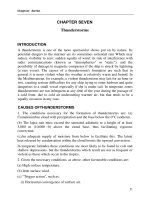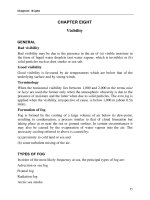BÀI GIẢNG KHÍ TƯỢNG THỰC HÀNH CHƯƠNG 11 12
Bạn đang xem bản rút gọn của tài liệu. Xem và tải ngay bản đầy đủ của tài liệu tại đây (257.08 KB, 12 trang )
CHAPTER 11 Observation of Ice Accretion
CHAPTER 11 Observation of Ice Accretion
Ice accretion (icing) is the growth in size, particularly by accumulation, of ice formed on the
ship's exposed surfaces.
Ice accretion is extremely hazardous in its effects on ships, particularly on vessels of less than
1,000 gross tonnage. On ships of the order of 10,000 gross tonnage it can cause radio and radar
failures due to the icing of aerials. Visibility from the bridge may also be affected. Troubles tend
to arise due to icing on the deck cargoes of large container ships. Apart from its possible effect on
stability it may cause difficulty in unloading cargo at the port of destination when containers and
their lashings are frozen solidly to the deck.
11.1 Ice accretion on ship
There are three main types of ice accretion depending on causes:
1) Ice accretion due to spray and sea water thrown up by the interaction between the ship
and the waves, and/ or due to spray blown from the crests of the waves
2) Ice accretion due to freezing rain, drizzle or fog
3) Ice accretion due to wet snow followed by a drop in temperature
Two or all of these types may occur simultaneously.
The type 1) is the most concerned for the ship. More detailed classification is required to be
reported.
According to studies on the meteorological effects on ice accretion in the western North
Pacific, general features are summarized as follows:
If the sea surface temperature is under 4't, ice accretion starts when the air temperature drops
to - 3°C and the wind speed increases to 8 m/ s. Strong ice accretion with growth rate of more
than 2 cm/hour takes place for further lower temperature (less than - 6°C) and larger wind speed
(more than 10m/s). If the sea surface temperature is less than 2°C, ice accretion starts for the air
temperature less than - 2't. The general relation among air temperature, wind speed and
characteristics of ice accretion is shown by Fig.11.1. One should remind however that with the air
temperature under -l7't, spray freezes before it is thrown up on the ship and therefore the growth
rate of ice accretion slows down. If you are navigating in the area where the sea surface
temperature is under 4°C and low air temperature and strong wind are expected, you should be
careful of the possibility of disasters caused by ice accretion on ship.
73
CHAPTER 12
CHAPTER 12
Port Meteorological Officer (PMO)
Port Meteorological Officer (PMO)
The Port Meteorological Officer (PMO) is defined by WMO as the official of the
Meteorological Service of a WMO Member who is stationed at a main seaport with the tasks of
maintaining liaison with weather observers on board ships, checking instruments, providing
advice, and contacting shipping authorities to enlist their cooperation in operating mobile ship
stations (weather station aboard a moving ship). The PMO visits ships to encourage them to
report weather and offers the following services free of charge:
- To check and calibrate instruments equipped on ships including barometers and to give
necessary advices.
- To provide instruction or assistance with regard to questions or inquiries on
meteorology or oceanography, specifically on marine meteorological observation and its
reporting.
- To explain such materials published by JMA as Marine Meteorological Logbook, Guide
to Weather Observation for Ships, Ship's Weather Code Card, etc. If requested, the PMO
supplies necessary copies.
- To inform the schedule of radio facsimile transmission from the meteorological services
for ships and explain how to receive and utilize it.
There are three PMOs in Japan as shown below. They are in Yokohama, Nagoya and
Kobe. You can also receive similar services from marine observatories in Hakodate, Maizuru
and Nagasaki. Note that the following E-mail address is common to all officers/ offices.
Port Meteorological Officers
Port Meteorological Officer, Yokohama Local Meteorological Observatory
99, Yamate-cho, Naka-ku, Yokohama, 231-0862JAPAN
fax: +81-45-622-3520, E-mail:
Port Meteorological Officer, Nagoya Local Meteorological Observatory
2-18, Hiyori-cho, Chikusa-ku, Nagoya, 464 -0039 JAPAN
fax: +81-52-762-1242, E-mail:
Port Meteorological Officer, Kobe Marine Observatory
1-4-3 Wakinohamakaigan-Dori, Chuo-ku, Kobe, 651-0073 JAPAN
fax: +81-78-222-8946, E-mail:
Other Port Meteorological Service Offices
Maritime Meteorological Division, Hakodate Marine Observatory
3-4-4, Mihara, Hakodate, 041 -0806 JAPAN
fax: +81-138-47-7682, E-mail:
75
CHAPTER 12 Port Meteorological Officer (PMO) Maritime
Meteorological
Division, Maizuru Marine Observatory 901, Shimofukui, Maizuru, 624
-0946 JAPAN
fax: +81-773-76-4114, E-mail: Maritime
Meteorological Division, Nagasaki Marine Observatory 11-51,
Minamiyamate, Nagasaki, 850-0931 JAPAN
fax: +81-95-823-8220, E-mail:
Headquarters
Marine Division, Climate and Marine Department, Japan Meteorological Agency 1-3-4,
Otemachi, Chiyoda-ku, Tokyo, 100-8122JAPAN
fax: +81-3-3211-6908, E-mail:
To maintain the accuracy of barometer for meteorological observations, it should be checked every
six months. H it is not possible for your ship to visit the above Japanese ports for a long time, you can
also have your barometer checked by the following ways;
1) H your ship will call at a foreign port in which a PMO is stationed, you can receive a PMO
service there regardless of flag.
2) In Japanese ports other than the above, you can have your barometer checked using facsimile on
request Please contact one of the Japanese PMOs for details.
76
Appendix 1
The list of supplies for ship's weather observations and
reports
-Al-
The JMA provides VOSs with the following materials free of charge:
Guide and tables for weather observation
Guide to Weather Observations for Ships
Guide to Ships' Weather Reports
Ships' Weather Code Card
Table for Finding the Dew-point Temperature
JMA Cloud Plate
Beaufort Scale of Wind Force
Materials for making weather observation reports
OBSJMA (Software on CD-ROM) and empty disks for storing the data
Operation Manual for OBSJMA
Ship's Weather Observation Field Note for OBSJMA
Marine Meteorological Logbook
Envelope to send logbooks or floppy disks (postage free within Japan)
Brochure
Marine Meteorological Observations and the Services of Port Meteorological Officers
Guide to Wave Chart
Marine Meteorological Information Services for Shipping and Fishing
Bulletin
The Ship and Maritime Meteorology
Appendix 2
Table for saturated vapor pressure
-A3-









